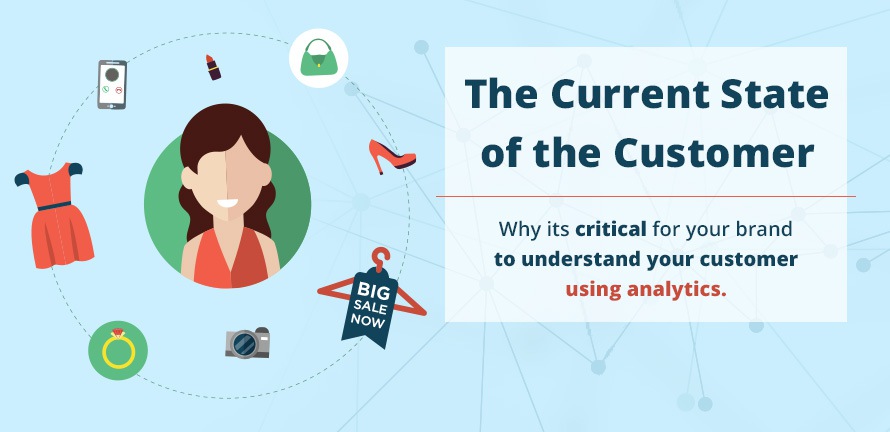With the rise of the information age, customers have gained an incredible amount of influence over companies. They expect consistent, high-quality experiences both digitally and physically, and companies must move quickly to gain their already-limited attention.
Understanding a consumer’s preferences and values has never been more important, and with the rise of big data and increasingly sophisticated tools, marketers can use their findings to create better brand experiences and products for consumers.
Your brand might have the data, but analyzing and deriving insights is another story. Here are some ways your brand can leverage analytics to better understand your customer and increase sales.
Predict Consumer Behavior
Many organizations are utilizing predictive analytics to make a customer’s experience as convenient as possible. Predictive analytics allows you to predict (to a degree) future outcomes based on historical data. One company that uses it very effectively is Netflix. They are able to collect massive amounts of data on their watchers to create a holistic view of each person. After analyzing the data, they are able to predict what kind of content will be enjoyable for each individual and continuously provide them with personalized recommendations.
Although predictive analytics is a powerful tool, it cannot produce insightful findings without high-quality data. Without setting an objective, your data will be irrelevant and will showcase no valuable information. What does your brand hope to achieve? Some examples may be:
- Which leads are most likely to convert?
- What type of content does my audience want?
- When are my customers browsing/researching?
- When are they ready to buy?
After selecting an objective, you can start collecting data across all channels knowing that your data is relevant and will produce informative insights.
Individualize your customer and Personalize Your Message/Content/Product/Service
Knowing who your customers are and what they want is crucial in the information age. Your customers have learned to ignore online ads, and have reduced attention spans and patience. Personalization impacts how consumers will perceive your brand, and even affects their willingness to buy your products and services.
- 63% of consumers said they’d think more positively of a brand if it gave them content that was more valuable, interesting, or relevant
- 77% of consumers have chosen, recommended, or paid more for a brand that provides a personalized service or experience
- Over 78% of consumers will only engage offers if they have been personalized to their previous engagements with the brand
The way to start is to segment your customers into groups by interest and analyze their behavior on the site. Track what they’re buying, browsing, and researching. Find out where your customers are exiting your page and see if there are things you can optimize to make the purchase path simple and efficient. E-mail them offers for complementary items that they can use with their previous purchases. TIP: They’ll be more likely to open and engage with the e-mail if you personalize it.
Eliminate Costs, Increase Effectiveness of Marketing Efforts
With a simple tool like Google Analytics, you’ll be able to see the ROI of each channel that you’re investing your time and effort into. You’ll have access to information that will help you allocate your budget to the most profitable channels. TIP: social media is a great channel for securing leads and building a brand image and awareness; however, if your social media isn’t providing you with desired conversions, highly-targeted, personalized emails may be the way to go!
Brands can also use analytics to effectively use paid social media channels. Let’s use Facebook as an example; they’ll be able to target consumers by location, interest, and time of interaction. They are all important because the more specific you are with your targeting, the less you will pay with CPC. Let’s look at an example using these three factors in the eyes of an upscale women’s apparel company.
- Location: Focus on urban cities that are fashion hubs. (E.g. Paris, New York City, Milan, London). Your ads will be more relevant and effective, and therefore cheaper with every conversion.
- Interest: Target your consumers by specifying their interests. Choose all things relevant to fashion and even by occupation. This will make sure that the right people are seeing the ad, which increases the likelihood of them clicking the ad.
- Time of Interaction: Scheduling when your ad shows on a person’s feed is very important. While you may be setting up a schedule for peak social media hours in New York, international tendencies may differ. Brands must look at the data to see what time works best for each location, and schedule accordingly.
Data allows brands to transition from product-centric companies to customer-centric ones. By understanding who their customers are and what they truly want, brands can give their consumers personalized experiences and relevant products to increase engagement and loyalty. Direct Agents helps brands gain insights into their customers and optimize the customer journey to be efficient and effective. We work with you to understand your business goals and create a strategy tailored to your specific needs.
Please email [email protected] so our team can help your brand create a successful, data-driven campaign that will resonate with your customers.



